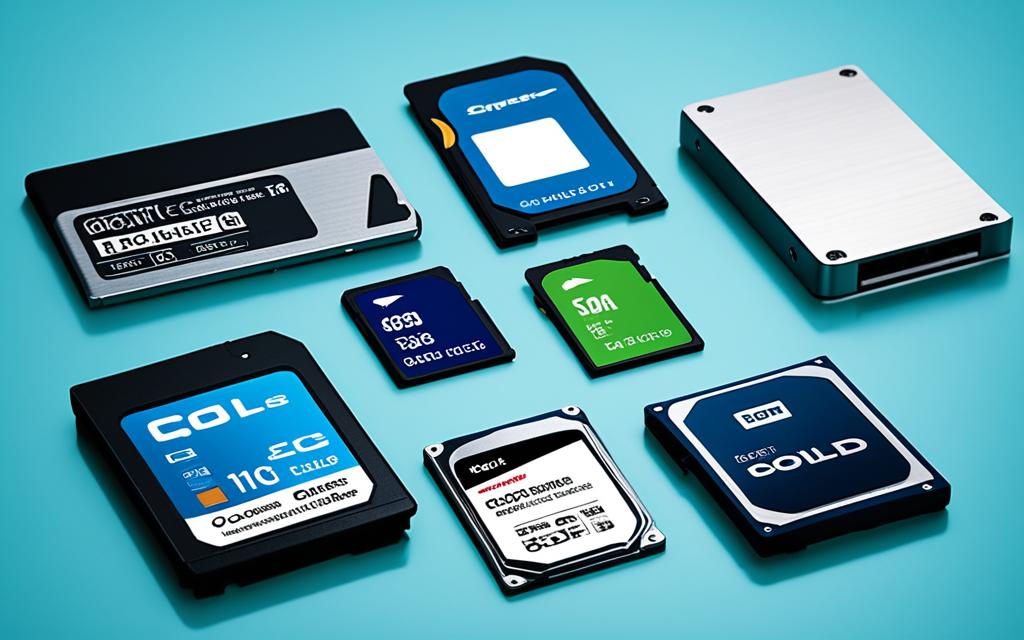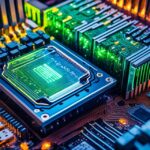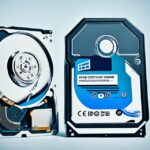Table of Contents
Today, we live in a world filled with digital marvels. The growth of computer storage devices enhances our experiences and system efficiency. They’re key for saving files, running applications, and keeping operating systems smooth. These devices vary in their roles and uses, deeply affecting our digital interaction. From modest megabytes (MB) to huge terabytes (TB), storage capacities span widely. Whether it’s the fast access of Random Access Memory (RAM) or the steadfastness of Read-Only Memory (ROM), each has its special role. They fit differently in tech environments, helping us find the best storage solutions.
Digging into storage devices reveals their unique qualities. They play a big role in computing performance. Recognising their traits helps us choose wisely for our needs. For a deep dive into computer memory, check out this informative resource.
Key Takeaways
- Computer storage devices are crucial for handling files and applications smoothly.
- We measure storage in MB, GB, and TB.
- Primary storage includes directly accessible options like RAM and ROM.
- Secondary storage consists of HDDs, SSDs, and optical discs.
- Knowing the storage types helps in achieving top performance and satisfaction.
The Importance of Computer Storage
Today, storing data is more important than ever. It’s essential for both people and businesses. The massive amount of data we create means we need good storage solutions. These help us keep our files organized. They make sure we can get to them fast, without any hassle.
Good storage keeps everything running smoothly. It lets us access what we need quickly. This is crucial for working efficiently.
Understanding Data Storage Needs
The need for storing data is growing fast. By 2025, experts think we will create 163 zettabytes of data. That’s a huge leap from the 16 ZB made in 20161. Just in 2020, we made or duplicated 64.2 ZB of data. This big increase means we need better ways to store and analyze data1.
The size of the data matters a lot. Simple files might only be a few kilobytes. But, videos or large pictures need much more space, often gigabytes1.
The Role of Storage in Computing Performance
How well storage works affects how good a computer is. If there’s not enough storage, things can get slow. This can make it hard to get anything done. Solid State Drives (SSDs) make computers faster. They help programs start quicker and files open without waiting2.
Memory cards and Network-Attached Storage (NAS) add more space. They’re great for all kinds of use, from personal to big companies2.
Primary Storage Devices
The world of primary storage devices is key in making sure computers work well. There are two main kinds: RAM and ROM. Each plays a vital role in handling data and running the system.
Random Access Memory (RAM)
RAM, short for Random Access Memory, acts as a computer’s short-term memory. It lets data be read and changed quickly. Since it’s volatile, all data vanishes when the power goes off. RAM is essential for running programs smoothly, boosting the system’s speed. There are different RAM types like DRAM, which needs refreshing to keep data, and SRAM, which is fast but volatile3.
Read-Only Memory (ROM)
On the other hand, ROM means Read-Only Memory. It’s non-volatile, so it keeps data even without power. ROM stores key instructions for starting up and operating hardware. It comes in types like PROM, EPROM, and EEPROM, each with unique features3. ROM’s data permanency is crucial for system reliability and access to vital functions4.
| Type of Storage | Volatility | Function |
|---|---|---|
| RAM | Volatile | Short-term data storage for applications in use |
| ROM | Non-volatile | Permanently stores instructions for booting up |
Knowing how RAM and ROM differ is vital for understanding computers. This mix of quick access and key instruction storage shows why primary storage devices are central to computing34.
Types of Computer Storage Devices
Knowing about the types of storage devices is key as they are central to computing. They can be split into primary, secondary, and tertiary storage. Each type is for different uses, depending on how often you need to access the data.
Overview of Storage Categories
Primary storage devices include RAM and ROM, vital for quick data access while processing. RAM stands for Random Access Memory. It acts as a temporary space for data during operations5. ROM, which means Read-Only Memory, does not lose data when the power is off. This makes sure important software is always ready6.
Differences Between Primary, Secondary, and Tertiary Storage
When comparing primary, secondary, and tertiary storage, we see many different options. Secondary storage has HDDs, SSDs, and optical media like CDs and DVDs. They offer more and lasting storage than primary types5. HDDs can keep up to 1 Terabyte of data. SSDs, famous for their speed and durability, are also an option7. Tertiary storage includes removable mass storage, which is more automatic and less common in home computing6.
To wrap up, there are many storage kinds, each suited to particular needs. Knowing how these storage types differ is essential. It helps in handling data effectively in our technology-filled lives.
| Storage Type | Characteristics | Examples |
|---|---|---|
| Primary Storage | Volatile, faster access, smaller size | RAM (SRAM, DRAM, SDRAM), ROM |
| Secondary Storage | Non-volatile, larger capacity | HDD, SSD, CD, DVD |
| Tertiary Storage | Long-term, less frequently accessed | Magnetic tape, external hard drives |
Source Links
- https://www.techtarget.com/searchstorage/definition/storage – What is computer storage and how is it used?
- https://www.lenovo.com/us/en/glossary/storage-device/ – Why do I Need a Storage Device? A Guide to Different Types
- https://www.shiksha.com/online-courses/articles/about-primary-storage-devices/ – All About Primary Storage Devices – Shiksha Online
- https://www.purestorage.com/knowledge/primary-vs-secondary-storage.html – Primary Storage vs. Secondary Storage: What’s the Difference? | Pure Storage
- https://unacademy.com/content/nda/study-material/computer/list-of-storage-devices/ – List of Storage Devices
- https://byjus.com/govt-exams/computer-storage-devices/ – What is a Computer Storage Device? | List of Important Storage Devices
- https://ticktocktech.com/blog/2022/08/15/different-types-of-computer-storage-devices-and-their-uses/ – Different types of computer storage devices and their uses
- https://aws.amazon.com/compare/the-difference-between-ssd-hard-drive/ – SSD vs HDD – Difference Between Data Storage Devices – AWS
- https://www.ibm.com/think/topics/hard-disk-drive-vs-solid-state-drive – Hard Disk Drive (HDD) vs. Solid State Drive (SSD) | IBM
- https://www.lenovo.com/us/en/glossary/secondary-storage-device/ – Everything You Need to Know About Secondary Storage Devices








